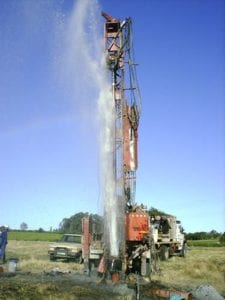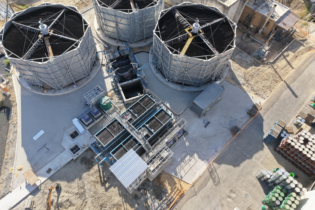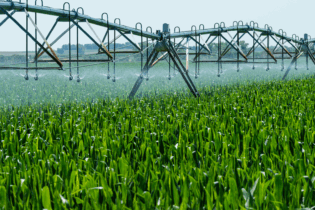Having spent many years finding groundwater sources to give towns and villages access to this precious resource, water users and water service providers in South Africa must start talking to each other to better manage scarce groundwater resources and avoid pumping the country’s aquifers dry.
This warning from Gert Nel, partner and principal geohydrologist in SRK Consulting’s East London office, comes at a time when some towns in relatively dry provinces are relying increasingly on groundwater, in the absence of sufficient surface water in rivers and dams. About 12 years ago, in the early years of starting up the SRK office in East London, Nel remembers working on groundwater feasibility studies to establish the quantity and quality of groundwater in various areas of the province. A number of well fields and boreholes were developed as a result; the issue now is to look after them. “South Africa is blessed with substantial but finite groundwater resources. If we don’t properly monitor and manage the boreholes we install, then groundwater resources can easily be overexploited and can run dry,” he says. “Then we have to repeat the whole costly process of finding other groundwater resources and accessing them, while remembering these opportunities are not limitless.” It is therefore vital that water service providers (usually the local municipalities) and private users (such as farmers) understand how much water is in the aquifers that they exploit, and how much offtake the aquifers can sustain. While helping find and access groundwater, SRK believes monitoring and management must be emphasised. “What we have aimed to do over the past couple of years is to convince authorities to fund the establishment of groundwater models as part of aquifer management,” states Nel. “A groundwater model is a scientific way of assessing how much water is available, how much is replenished through rainfall and other sources such as rivers, and how much can actually be abstracted over a period before we threaten the sustainability of the aquifer.” This gives authorities and users an overview of water availability in their area. This has proved to be a good starting point for water planning strategies, although it does not by itself solve the problem. Local authorities, for example, have generally only looked at their own use – the use by the homes and businesses they supply within their jurisdiction of towns and villages – when checking their abstraction levels against the flow potential of the aquifer. The ‘private use’ of groundwater – mainly by farming communities – is often not included in the calculation because farms are usually not supplied by local authorities. “What we’ve seen is that private abstraction for irrigation often makes up a significant portion of what is pumped from an aquifer,” he explains. “When asked by water authorities to recommend how much water they can pump for their needs, we may conclude that there is enough potential in an aquifer to satisfy the town. But if we add in the demand from, for example, the farming community close to the town, we realise that the aquifer could run dry over just a few years.” This of course demands greater cooperation between the municipalities and the agricultural sector, an area of sensitivity as many farmers have in the past generally been left to operate on their own in this regard. “The law is clear that groundwater is a public asset – it does not belong to the person on whose land it occurs,” says Nel. “So private users cannot use as much as they want, or as much as they can pump from their boreholes. That is why the law requires private users to register their water abstraction with the Department of Water Affairs.”As one of those provinces with insufficient surface water, the Eastern Cape is growing more dependent on groundwater, with many municipalities looking to develop more production boreholes on private properties – another reason for greater cooperation between these parties.
“So the challenge is to get the authorities and private users around a table to explain the need for better groundwater management, as in many cases they are both pumping from the same aquifers,” he continues. “The danger is that, without sufficient cooperation, the resources will be depleted, leaving both parties without water at the end of the day.” Nel adds that this is not so much an issue in areas where government is the main landowner (for example, where land is communal), but the concern is mainly where towns are dependent on groundwater – and farmers in the area have historically used groundwater for their irrigation needs. “There are some Karoo towns, for instance, which are facing these challenges already; abstraction levels have grown substantially over time and they could face the depletion of their current water source within the next few years,” he comments. The Department of Water Affairs, as the overall custodian of the country’s water resources, is legally empowered to authorise water use, a process in which it applies terms and conditions. However, before it authorises water use, it would have to take into account other abstractions in the area. “The problem is that many private users do not apply for these authorisations, so the department may not be fully aware of how much water is being taken from any specific area,” Nels says. “When the municipality applies for a water use authorisation in the same area, it is very likely that it will be granted, as the department must assume from its records that there is limited abstraction by private users in the area.” According to Nel, the department is still working to get all large private users to register their boreholes and their pumping levels – an initiative it began pushing in the 1980s. “The Department of Water Affairs needs this information; if there is large-scale private abstraction in an area where the municipality also needs groundwater, there is always going to be the danger of depletion,” he says. “And when a municipality runs out of water, the first place they turn to is the department; while it’s not the department’s responsibility, it often becomes its problem. Implementing a groundwater model as part of a groundwater management strategy, and ongoing monitoring, would help avoid this problem.” There is a further issue of skills and financial capacity at local level. As the water service provider, the local municipality has traditionally not focused on the protection of aquifers as this requires extra funding and certain scientific skills for monitoring and management, according to Nel. “Local authorities tend to prioritise the mandate of delivering water of sufficient quality to their customers, but in fact they are also responsible for managing their local sources of water, not just the provision of water to the community,” he states. “The Department of Water Affairs aims to protect water resources on a regional scale, and is not going to manage the municipalities’ water sources for them.” Specialist engineering skills can be brought in to help tackle these important tasks, if there is a lack of expertise – but funding these specialised inputs continues to be a challenge, he concludes.







